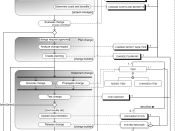Organizational change is usually triggered by relevant environment shift, either internal or external, that sensed by companies and leads to intentionally generated response (French, Bell & Zawacki, 2006). This paper will discuss several organization development models..
Theories of Change
In order to survive and prosper in a rapid changing environment of business world, organization is often required to generate fast response to changes (French, Bell & Zawacki, 2005). Change management means to plan, initiate, realize, control, and finally stabilize change processes on both, corporate and personal level. Change may cover such diverse problems as for example strategic direction or personal development programs for staffs. In this section, several theories of change will be discussed to improve our understanding of change management in theory and practice.
Kurt Lewin's Three-StagesChange Model
Kurt Lewin's three stage force field theory provides guidance for organizational change which involves unfreezing, movement and refreezing.
The first step in this process of change is to unfreeze the current situation, followed by a change or movement. The last step in this process is refreezing step to make the new behaviors stick (Levasseur, 2001). Disconfirmation, cognitive redefinition, and induction of survival anxiety are three processes associated with unfreezing (Schein, 1999). When dissatisfaction occurs it signals change is needed resulting in disconfirmation (Schein). The feelings, attitudes, and values associated with learning to use the new behaviors and changing the current behaviors refers to cognitive redefinition. Movement takes place when management plans and implements the move including making modifications and educating staff on new organizational behaviors. Refreezing is defined as a new behavior in conjunction with the old behavior of individuals (Schein).
Lippitt, Watson and Westly's Seven-Phase Model
Based on the Lewin three-phases model, Lippitt, Watson, and Westley refined Lewin's model a seven-phase model (French, Bell & Zawacki, 2005). The sever-phase model is proposed as follows:
* Phase 1 corresponds to Lewin's unfreezing phase in which a need for change is developed (French et al, 2005).
* Phase 2 is to establish a change relationship in which a client system needs help and a change agent from outside establish a working relationship with each other (French et al, 2005).
* Phase 3 to clarify or diagnosis of the client problem (French et al, 2005).
* Phase 4 to establish goals and actions, and propose the alternative goals and actions (French et al, 2005).
* Phase 5 to transform of intention into actual change efforts. All phase 3, 4 and 5 correspond to Lewin's moving phase (French et al, 2005).
* Phase 6 corresponds to Lewin's freezing phase to generalize and stabilize change (French et al, 2005).
* Phase 5 achieves a terminal relationship (French et al, 2005).
The refined seven-phased model are foundations of the organizational development discipline and advanced both theory and practice in OD
Kotter's Eight-Step Model
One of the OD models that stand out as exemplars in the change management literature is the Kotter's eight-step model for transforming organization (Mento, Jones & Dirndorfer, 2002). Kotter developed the model after a study of over one hundred organizations that very in size and type (Mento et al). Kotter's model is best viewed as a vision for the change process and for avoiding major errors in the change process (Mento et al). The model calls attention to the key phases in change process. The Kotter's eight-phase model proposed as followed.
* Establish a sense of urgency because opportunities or crisis demand a change now
* Create a guiding team to form change agents with credibility, authority and skill to assist in the change process
* Develop a change's vision and strategy
* Clearly communicate the change vision
* Empower the individuals involved in the change process by removing obstacles, changing structure, rewarding new ideas.
* Generate short-tem success, celebrate and reward early success
* Consolidate gains and continue change
* Make change stick to anchor new behavior into the culture
It is noted that the model provides two key lessons. The first lesson is that the change process goes through a series of phases that are long and considerable amount of time. The second lesson is that any mistakes that occur in any phases can have a adverse impact on the momentum of the change process (Mento, Jones & Dirndorfer, 2002).
Concerned Based Adoption Model (CBAM)
CBAM is considered a widely applied theory and methodology for studying the change process of educational change (Anderson, 1997). CBAM is developed under the assumptions that (1) change is not an event but is a process; (2) change is carried out by individuals; (3) change is a highly personal experience; (4) changes involves in both developmental growth of feeling and skills; (5) change can be facilitated by interventions directed toward individuals. (Anderson). There are sever stages of concerns that describe the feeling and motivations of individual might have about the change (Anderson).
* Stage 0, awareness - at this stage, individuals have little knowledge about or interested in the change
* Stage 1, Informational - at this stage, individuals like to know more or interested in the innovation and implication of change implementation
*Stage 2, Personal - at this stage, individuals reflect strong anxieties about the change and how the change will affect them
*Stage 3, Management - at this stage, individuals begin to experience with the change process and are more concerned with processes and tasks in the change process
*Stage 4, Consequence - at this stage, individuals focus predominantly on the impact of the change
*Stage 5, Collaboration - at this stage, individuals are interested in working with each other to improve the benefit of the change implementation
*Stage 6, Refocusing - at this stage, individuals are interested in thinking of additional alternatives that might work better and ready to move on
As mentioned above, CBAM is more suitable to change implementation in the classroom environment because CBAM assumes that classroom change can be facilitated (Anderson, 1997). By using CBAM, people who are in charge of the change can access individuals concerns about a change, their level of use and their configuration of use (Anderson). The information can be used to clarify problems, arouse interest and generate possible solution.
Structural Adaptation to Regain Fit (SARFIT)
The last OD model that is discussed in this section is the Structural Adaptation to Regain Fit or SARFIT which were developed by Donaldson. The important key of SARFIT theory is that in order to maintain and improve performance, company or organization must fit their structure to the contingency factors (Donaldson, 1987). There are five stages in SARFIT model (Donaldson, 1996)
*An organization must be in fit
*There must be an contingency change
*The organization suffers performance and is in misfit
*The organization does structural adaptation
*The organization recover the performance and achieves a new fit
In SARFIT model, strategic choice plays role in that "the organization bows to the imperative of adopting a new structure that fits its new level of the contingency factor in order to avoid loss of performance from misfit" (Donaldson, 1996). In addition, it is also noted that it is often that the organization acknowledge it is in misfit and needs to adapt new structure only after it suffers a severe loss of performances.
References:
Anderson, S. (Fall 1997). Understanding teacher change: Revisiting the Concerns Based Adoption Model. Curriculum Inquiry, 27(3), pp. 331-368. Retrieved December 2, 2006 from EBSCO Host, AN 9710272126.
Bloisi, W., Cook, C. & Hunsaker, P.(2003). Management and Organisational Behavior: European Edition. Berkshire: McGraw-Hill Education
Bolognese, A. (2002). Employee Resistance to Organizational Change. Retrieved December 2, 2006 from Internet, http://www.newfoundations.com/OrgTheory/Bolognese721.html
Donaldson, L. (January 1987). Strategy and Structural Adjustment to Regain Fit and Performance: In Deference of Contingency Theory. Journal of Management Studies, 24(1), pp. 1-25. Retrieved December 2, 2006 from EBSCO Host, AN 4556077.
Donaldson, L (1996). The Normal Science of Structural Contingency Theory. Handbook for Organization Studies, ed. Sage Publications.
French, W., Bell, C. & Zawacki, R. (2005). Organization Development and Transformation: Managing Effective Change (6th ed.). The McGraw-Hill Companies, Inc.
Levasseur, R. (Jul/Aug 2001). People Skills: Change Management Tools--Lewin's Change Model. Interface, 31(4), pp. 71-73. Retrieved December 2, 2006 from EBSCO Host, AN 5720128.
Schein, E. (August 1999). Kurt Lewin's Change Theory in the Field and in the Classroom: Notes Toward a Model of managed Learning. Reflections, 1(1), pp. 59-74. Retrieved December 2, 2006 from EBSCO Host, AN 6798038).
Mento, A., Jones, R. & Dirndorfer, W. (August 2002). A change management process: Grounded in both theory and practice. Journal of Change Mangement, 3(1), pp. 45-70. Retrieved December 2, 2006 from EBSCO Host, AN 7329277
Welbourne, T. (1995). Fear: The Misunderstood Component of Organizational Transformation. Human Resource Planning, 18(1), pp. 30-37. Retrieved December 2, 2006 from EBSCO Host, AN 9601111246.
Worley, C. & Yvonne, V. (n.d.). Leading change management involves some simple, but too often forgotten rules. A Journal of Relevant Business Information and Analysis. Retrieved December 2, 2006 from Internet, http://gbr.pepperdine.edu/052/change.html



Good Work
A lot of infromation, really supports my assignment.
0 out of 0 people found this comment useful.